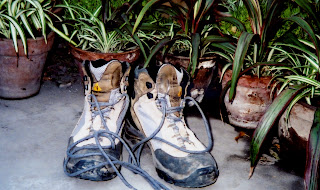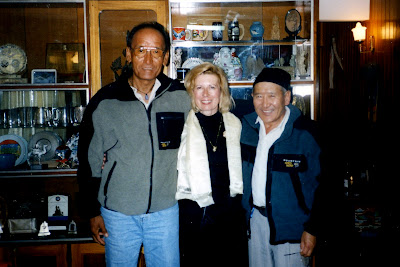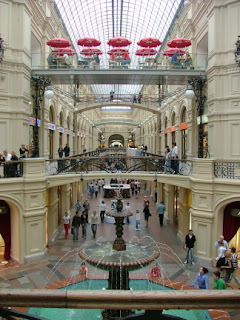1992-2007

Diego was a brave, loyal and loving kittie.
His gentle spirit is free to travel the world.


 When we finally found the Pushkin and walked in, it took us a bit to find the exhibit we were looking for. The docents either didn’t speak English or they didn’t understand why we would be looking for the Trojan exhibit. We finally found it and it was pretty nice. Just about everything was gold and intricate. I think Kathie was satisfied; she’d gotten her antiquities fix for the day.
When we finally found the Pushkin and walked in, it took us a bit to find the exhibit we were looking for. The docents either didn’t speak English or they didn’t understand why we would be looking for the Trojan exhibit. We finally found it and it was pretty nice. Just about everything was gold and intricate. I think Kathie was satisfied; she’d gotten her antiquities fix for the day. Walking through the crowd at the north end of Red Square, we passed several street vendors. One guy had a monkey and a falcon chained to a wooden crate. Very sad and truly weird. Can’t imagine seeing something like that in NYC. Now, a naked cowboy playing a guitar maybe…
Walking through the crowd at the north end of Red Square, we passed several street vendors. One guy had a monkey and a falcon chained to a wooden crate. Very sad and truly weird. Can’t imagine seeing something like that in NYC. Now, a naked cowboy playing a guitar maybe… The square itself was barricaded off and deserted - except for a pathetic little parade of six or eight peeps waving Communist Party placards. When they passed, the uniformed guys removed the barricades and the square filled with people again, but not before Kathie could snap this shot.
The square itself was barricaded off and deserted - except for a pathetic little parade of six or eight peeps waving Communist Party placards. When they passed, the uniformed guys removed the barricades and the square filled with people again, but not before Kathie could snap this shot. We returned to the blini place in GUM where we saw a couple of our fellow cruisers, Diane and Ruth, who asked us for directions back to the ship. We told them we’d take them back by way of the Metro, if they liked, right after we visited Varvarka Street. They were game, so after we finished our lunches, we set out for Varvarka.
We returned to the blini place in GUM where we saw a couple of our fellow cruisers, Diane and Ruth, who asked us for directions back to the ship. We told them we’d take them back by way of the Metro, if they liked, right after we visited Varvarka Street. They were game, so after we finished our lunches, we set out for Varvarka.

 At one point, a man who looked to be in his forties and wearing worn fatigues approached us with an offer to sell us some Moscow postcards. We smiled and said, “Nyet, spacibo,” to him and turned back to our discussion regarding how to get to the Church of the Trinity in Nikitniki (I think that’s what we were looking for - wasn’t it, Kath?) He proceeded to give us directions in unaccented American English, shocking us all. I don’t remember his story now, why he had spent time in the U.S., but he was a nice guy and we thanked him for his directions and crossed the street in our quest.
At one point, a man who looked to be in his forties and wearing worn fatigues approached us with an offer to sell us some Moscow postcards. We smiled and said, “Nyet, spacibo,” to him and turned back to our discussion regarding how to get to the Church of the Trinity in Nikitniki (I think that’s what we were looking for - wasn’t it, Kath?) He proceeded to give us directions in unaccented American English, shocking us all. I don’t remember his story now, why he had spent time in the U.S., but he was a nice guy and we thanked him for his directions and crossed the street in our quest. The ship left for St. Petersburg at 5:30. Kathie and I were sad to leave Moscow. Inga had told us that we would like St. Petersburg better, but we doubted that would be possible.
The ship left for St. Petersburg at 5:30. Kathie and I were sad to leave Moscow. Inga had told us that we would like St. Petersburg better, but we doubted that would be possible.

 They had been here to leave her flowers on the Tomb of the Unknown Soldier, which lies alongside the brick wall of the Kremlin. The eternal flame burns for the twenty million Russians who perished in World War II.
They had been here to leave her flowers on the Tomb of the Unknown Soldier, which lies alongside the brick wall of the Kremlin. The eternal flame burns for the twenty million Russians who perished in World War II. Crossing Red Square to enter GUM, Kathie snapped this shot of Savior Tower, once the Kremlin’s main entrance but now closed to the public. The clock chimes supposedly play the Russian national anthem. We never heard it. We were too busy looking for the entrance to GUM.
Crossing Red Square to enter GUM, Kathie snapped this shot of Savior Tower, once the Kremlin’s main entrance but now closed to the public. The clock chimes supposedly play the Russian national anthem. We never heard it. We were too busy looking for the entrance to GUM. Now some people think that GUM is a department store. It’s actually a three-story mall, built in the late 19th century, that originally housed a thousand shops. Count 'em - 1,000. The name GUM is an acronym for Government Universal Store (or “Magazin”, if you must know). The shops these days include Benetton, Gap, Christian Dior, and Estee Lauder – just to name a few, and it looks like this.
Now some people think that GUM is a department store. It’s actually a three-story mall, built in the late 19th century, that originally housed a thousand shops. Count 'em - 1,000. The name GUM is an acronym for Government Universal Store (or “Magazin”, if you must know). The shops these days include Benetton, Gap, Christian Dior, and Estee Lauder – just to name a few, and it looks like this. Kathie and I found a little blini/sandwich place where we had lunch and did some more peoplewatching. The young waitress was slow and unfriendly, but the food was pretty good.
Kathie and I found a little blini/sandwich place where we had lunch and did some more peoplewatching. The young waitress was slow and unfriendly, but the food was pretty good.










 When our guide had had enough, we re-emerged into the afternoon sunlight to find our bus waiting to take us to Arbat Street. No cars are allowed on Arbat, so we strolled along and looked in windows and listened to street musicians. I swear – from what we saw, every Russian plays an instrument or sings. Well.
When our guide had had enough, we re-emerged into the afternoon sunlight to find our bus waiting to take us to Arbat Street. No cars are allowed on Arbat, so we strolled along and looked in windows and listened to street musicians. I swear – from what we saw, every Russian plays an instrument or sings. Well. Waiting for the bus, we snapped these shots of the Ministry of Defense building. Yup, it’s another of Stalin’s skyscrapers. Cool, huh? I guess no one wanted to climb up there and blast off that hammer and sickle...
Waiting for the bus, we snapped these shots of the Ministry of Defense building. Yup, it’s another of Stalin’s skyscrapers. Cool, huh? I guess no one wanted to climb up there and blast off that hammer and sickle...

 Here’s Novodevichy (New Maiden) Convent. Most of the compound was built in the late 1600s by Peter the Great’s half-sister, Regent Sophia. Well, actually, she didn’t build it herself. She had it built because Peter confined her to the convent for the rest of her life, even after she had spent seven years of her life acting as the stand-in for him until he got old enough to rule. Now that’s gratitude for you. She should have squashed the guy like a palmetto bug, except that he was seventeen years old and seven feet tall. Yikes.
Here’s Novodevichy (New Maiden) Convent. Most of the compound was built in the late 1600s by Peter the Great’s half-sister, Regent Sophia. Well, actually, she didn’t build it herself. She had it built because Peter confined her to the convent for the rest of her life, even after she had spent seven years of her life acting as the stand-in for him until he got old enough to rule. Now that’s gratitude for you. She should have squashed the guy like a palmetto bug, except that he was seventeen years old and seven feet tall. Yikes. Here’s Moscow University. Located in Sparrow Hills, it’s one of eight (or seven, depending on whom you ask) of Stalin’s Skyscrapers (or wedding cakes, also depending on whom you ask). Tuition is free. Woof. Kathie got this great shot by crossing the street so that the overhead lines running above the sidewalk wouldn’t show up in the final product. (I’m lazy – almost all of my building photos have overhead wires.)
Here’s Moscow University. Located in Sparrow Hills, it’s one of eight (or seven, depending on whom you ask) of Stalin’s Skyscrapers (or wedding cakes, also depending on whom you ask). Tuition is free. Woof. Kathie got this great shot by crossing the street so that the overhead lines running above the sidewalk wouldn’t show up in the final product. (I’m lazy – almost all of my building photos have overhead wires.)
Kathie's photo.

My photo. See the difference?
Interesting history. The cathedral was built between 1839 and 1883 to celebrate Moscow’s victory over Napoleon. In 1931, however, Stalin decided the site would be perfect for his Palace of Soviets, the ninth (or eighth, depending on – well, you know) of his gothic skyscrapers, so he had the cathedral blown up. For whatever reason – lack of funds, the intervening war, and/or too many other projects going on - the palace didn’t happen; the remaining foundation was therefore turned into an outdoor pool instead. In the 1990s the pool was filled in and the original structure was reproduced at a cost of $200 million, most of which came from the government. How’s that for irony?

OK, so I couldn't...
 resist just a couple of shots...
resist just a couple of shots...

Sheremetevo Airport, Moscow
This would have all been just ducky except that Kathie had bought us tickets for Swan Lake at the Bolshoi that evening. We finally arrived at the ship at 7 pm (the show was supposed to start at 7) and changed clothes at the speed of light (yuck – no time for a shower after twenty and a half hours of traveling). We planned to take a cab over to the theater, but then someone knocked on our cabin door as we started to leave, and I opened it to find Inga Zakharova, a pretty red-haired Russian woman who had been trying to give us directions at the desk. She obviously knew we were in too much of a dither to know what we were doing at that point.
“Are you ready? Let’s go. I’m going to walk you over to the Metro station.”
Kathie and I were shocked by such a kind offer. We flew out the door behind her and took off at a trot (in our Chico’s outfits, mind you) trying to keep up with her. As usual, I lagged a few steps behind, trying to memorize the route so I could get us back to the ship after the ballet.
When we arrived at the Metro station, Inga helped us buy round-trip train tickets and pointed out on the Metro map our current location and our destination. Thanking Inga profusely, Kathie and I waved goodbye and descended into the bowels of the Metro to board our train.
To say we were conspicuous would be an understatement. Here we were, sweating from our hike in our going-to-the-ballet clothes, riding Moscow’s subway with Russian kids listening to their iPods, workers making their end of the day commute, and little old babushkas toting their day’s groceries in Estee Lauder shopping bags (I kid you not!). I’m reading every sign and advertisement on the train wall because I’m as fascinated as I can be by everything around me and cannot control my curiosity, and I’m just thrilled to find that I can still read Cyrillic. (Long story – don’t ask.) So yeah, little kids were staring at us.
When we arrived at our station and resurfaced – I gotta tell you, the Metro escalators are about a quarter of a mile long and that is no joke - we were more than a little intimidated by what we saw. The square before us was surrounded by a bunch of buildings, any of which could be the Bolshoi. We stopped a couple of nicely dressed Russian ladies for directions.
“Izvenitye, gde Bolshoi?” I asked haltingly in my telltale American accent.
“(Something, something, something in Russian) perekhod (then something else in Russian) vnizh (and something else in Russian)”, I understood the lady on the left to say, as she gestured with her hand. I vaguely remembered the words “perekhod” and “vnizh” from thirty years ago, and figured she meant for us to walk around the square in front of us and down under the street to get to the other side.
Approaching the huge building that we figured must be the Bolshoi, we suddenly realized that we should have asked the lady for directions to the New Bolshoi. (Shortly before the trip, I had discovered online that the original Bolshoi closed in 2005 for a three year renovation, but supposedly the New Bolshoi was right next door to the old one. Likely story. There are only about a gazillion buildings next door to the old Bolshoi, and not a one of them has any kind of name or sign on the front.)
So we approached another nicely dressed lady for directions. “Izve…”, I started to say.
She walked on by, not slowing or even looking at us. I think Kathie would have taken her out if we hadn’t been in a bit of a hurry.
We walked further and asked some kids in their late teens, maybe early twenties, who appeared to be friendly. I think they were intrigued by us. A couple of them could speak a little English, but none had ever heard of the New Bolshoi. We showed them our tickets, on which was stamped the name of the theater in Cyrillic. One of the guys went over to a street kiosk and asked for directions, then came back and with gestures, some English, and some Russian, got us headed in the right direction.
We found the building but couldn’t figure out which door to enter. A balding, heavyset wiseguy offered to give us directions for $5. By now, Kathie and I were both about ready to tell the guy to “f--- off” (which would be unusual for Kathie), but we turned instead and walked off. The guy called after us and pointed to the correct door.
“Whew!” we sighed as we entered the building and handed our tickets to the lady at the door. Saying nothing, she pointed ahead and toward the right. We finally got to the right place after asking several people who, of course, didn’t understand us, for more directions. By now, however, it was going on 8:00 and intermission was about to begin, so the usher waved us over to a monitor where we could watch the show while we waited.
And believe me, the theater and ballet were worth the wait and all the struggle to get there. The inside of the theater was stunning. While Kathie took advantage of intermission to snap some shots, I sat in my second row – I repeat, second row – seat and just took in the view. Supposedly, the original Bolshoi is bigger and even more lavish. I gotta see that place.
The ballet itself was awesome. The props and stage were larger than life, the costumes were rich and glittery, and the Prince and Swans were more talented and moving than anything I’ve ever seen. If I could do one of those really loud fingers in the teeth whistles, this show deserved it. Instead, we just clapped and yelled “Bravo” with the rest of the crowd.




 Top of Misery Hill
Top of Misery HillGiven our 600' mistake, we were ahead of other climbers and the first to summit for the day. The summit is a small snow and rock ridge, and I was perfectly content to say I had summited having reached the top of the ridge. According to Joe, however, the true summit is a crag reached only by a narrow snow and ice ridge, with a steep drop off, several thousand feet on one side and enough on the other it didn't make any difference. An ice axe wouldn't save you if you slipped here in either direction. Joe crossed to the true summit, man's man that he is. I thought, "I really don't need to do this," but after watching Joe I thought, "I CAN do this".




